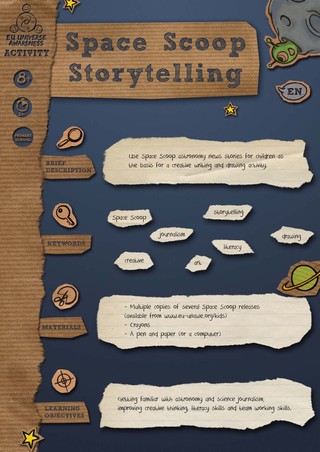Space Scoop Storytelling
Brief description: Use Space Scoop astronomy news stories for children as the basis for a creative writing and drawing activity.
Keywords: Space Scoop, storytelling, drawing, literacy, art, creative, journalism
Time: 2-3 hours
Level: Primary school
Age: 8+
Materials needed: Multiple copies of several Space Scoop releases (available at www.eu-unawe.org/kids), crayons, a pen and paper (or a computer)
Learning objectives: Getting familiar with astronomy and science journalism and improving creative thinking, literacy and teamwork skills.
Background information: While professional astronomers strive to further our understanding of the Universe, science communicators are doing an equally important job: sharing this new knowledge with the public. Astronomy communication is especially important for children, where the aim of highlighting exciting new discoveries is to inspire them to develop an interest in science and technology.
Full description of activity:
EU Universe Awareness (EU-UNAWE) has created an astronomy news service for young children, called Space Scoop (www.eu-unawe.org/kids). The idea behind Space Scoop is to change how astronomy and space sciences are often presented to young children as historical subjects. By sharing exciting new astronomical discoveries with them, we aim to inspire them to develop an interest in science and technology.
In addition to being a fantastic resource to introduce young children to the world of science, Space Scoop can also be used as reference material by teachers for developing lessons in creative writing and drawing.
Step 1: Print out lots of different Space Scoop releases. Divide the children into groups in different parts of the classroom and distribute the articles so that the children only see the Space Scoop that they are working on.
Step 2: Tell the children to imagine that they are in a spaceship (they can be human or alien) and that they can see the astronomical object(s) or event mentioned in the Space Scoop release.
Step 3: Ask them to write a description of the object(s) or event in the form of an eyewitness account. Emphasise the need to use lots of adjectives.
Alternative: Ask the children to re-tell the Space Scoop in the form of a poem.
Step 4: Tell the children to swap their stories with someone from a different group. Then ask them to draw a picture of the astronomical object or event described by their classmate. The drawing must be based solely on the eyewitness account and not on the original Space Scoop.
Step 5: Ask the children to pair up with the person that they swapped their story with. Are the drawings similar to what the storytellers had imagined the objects or event would look like when writing their eyewitness accounts (or if they are similar to the picture used in the Space Scoop)? If they are different, ask them to try to figure out why. Could the storyteller have included more description to help the reader? Or is this astronomical object or event so strange and bizarre that there are many possible ideas for what it may look like, all of which are equally right? Do professional astronomers even know how it really looks?
Credit:
EU-UNAWE/S. Reed
Share:
Images
Files








